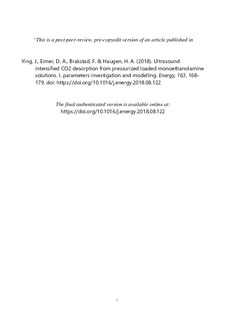| dc.contributor.author | Ying, Jiru | |
| dc.contributor.author | Eimer, Dag-Arne | |
| dc.contributor.author | Brakstad, Frode | |
| dc.contributor.author | Haugen, Hans Aksel | |
| dc.date.accessioned | 2019-03-15T08:45:32Z | |
| dc.date.available | 2019-03-15T08:45:32Z | |
| dc.date.created | 2018-10-15T09:45:24Z | |
| dc.date.issued | 2018 | |
| dc.identifier.citation | Energy. 2018, 163, 168-179. | nb_NO |
| dc.identifier.issn | 0360-5442 | |
| dc.identifier.uri | http://hdl.handle.net/11250/2590148 | |
| dc.description.abstract | CO2 stripping from loaded monoethanolamine (MEA) aqueous solutions intensified by means of ultrasound was investigated in a lab-scale kettle reboiler with both gas and liquid continuous operations. The reboiler operating conditions were similar to those of a typical industrial reboiler with a pressure of 1 barg, and where the CO2 loading is less than 0.25 mol CO2/mol MEA. Intermittent ultrasound application was tested to find the effects of variables for CO2 stripping from the CO2 loadings 0.20–0.39 mol/mol at pressures up to 1.5 barg. Multi-variate data analysis was employed, and a model was built to explain and find the effects of six variables on CO2 stripping by ultrasound. The six variables include pressure, liquid flow rate, CO2 loading, intensity, frequency and on-stream time of ultrasound. The variable analysis results manifest that the CO2 loading is the significant positive effect variable, pressure is negative on energy saving and CO2 stripping rate and ultrasound parameters have varied effects. Experimental results show that the CO2 stripping rate assisted by ultrasound is 4 times than by heat only when CO2 loading is high, and the best result of specific energy consumption was 2.3 MJ/kg CO2 in the present test conditions. | nb_NO |
| dc.language.iso | eng | nb_NO |
| dc.title | Ultrasound intensified CO2 desorption from pressurized loaded monoethanolamine solutions. I. parameters investigation and modelling | nb_NO |
| dc.type | Journal article | nb_NO |
| dc.type | Peer reviewed | nb_NO |
| dc.description.version | acceptedVersion | nb_NO |
| dc.source.pagenumber | 168-179 | nb_NO |
| dc.source.volume | 163 | nb_NO |
| dc.source.journal | Energy | nb_NO |
| dc.identifier.doi | 10.1016/j.energy.2018.08.122 | |
| dc.identifier.cristin | 1620299 | |
| cristin.unitcode | 222,58,3,0 | |
| cristin.unitname | Institutt for prosess-, energi- og miljøteknologi | |
| cristin.ispublished | true | |
| cristin.fulltext | postprint | |
| cristin.qualitycode | 2 | |
